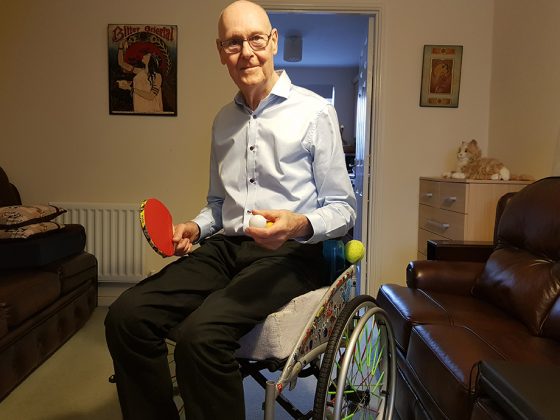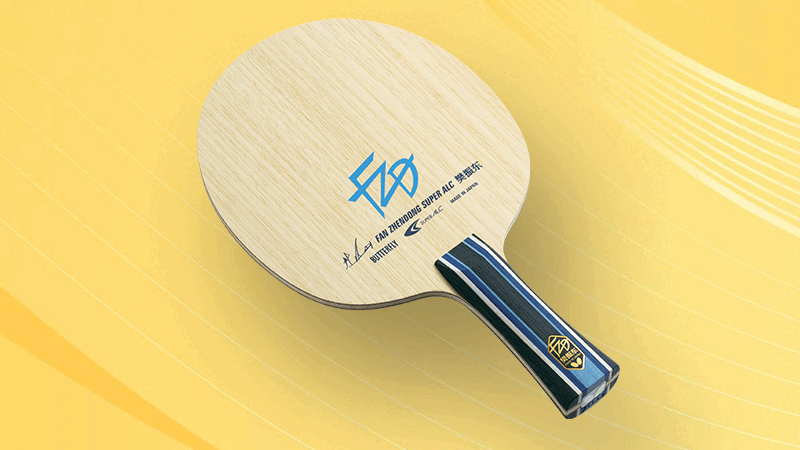Michael Swan is determined to reassure table tennis players that emulating his transition from standing to wheelchair play should be nothing to worry about.
Michael only started playing at the age of 67 when his local church received a donation of two tables. He picked up the skills quickly and honed them at local clubs.
However, after around three years, arthritis in his knees meant he had to reassess how he played.
With help from local clubs and coaches near his home in West Auckland, County Durham, Michael made the transition to playing in a wheelchair around three years ago.
Having been through all aspects of the journey, including equipment research, he is well placed to offer advice to others who can no longer play standing up, but who want to remain in the sport.
Michael, a 73-year-old retired painter and decorator, said: “Our local church, West Auckland Vineyard Church, was donated a couple of tables. There were some players in the church and met up on a Monday afternoon to play. I went along and got thoroughly thrashed because I couldn’t play, so I decided to find a local club and see if I could learn anything.
“A coach taught me the basic forehand and backhand shots, and I practised on the kitchen table and within about three months I was beating the players in the church group. I took to the sport and it was for me.
“I joined Bishop Auckland Table Tennis Club and met their coach Matt Porter and I played in their league team about a year later.”
When Michael transitioned to a wheelchair, it was Matt who helped him adjust his game.
“Matt told me about things like taking the handles off the chair and putting tennis balls on, and the 15cm cushion you’re allowed to put on the chair.
“The hardest thing about going from standing to wheelchair is the change of height, so by putting that cushion on there, it gives me a bit of height.
“We had a problem with my knees getting under the table, so we cut the edge of the cushion and that dropped my thighs. Then I took the footrests off and that was basically it.
“Eventually, I could play just as well in this adapted wheelchair as I could as a standing player. I was beating people who were at my level and I was quite pleased with that.
“One of the big shots in table tennis is the forehand topspin and I was able to do that in a wheelchair – I can get that stroke because I can get my arm right down low and play it using my waist.”
Michael now plays at Darlington Academy and has also passed his Level 1 coaching qualification.
He has this advice for clubs and coaches to help wheelchair players: “The one thing a club needs is a wheelchair. I’ve seen older people drop out of the sport because they’ve got bad knees, or a bad back, or the hip goes, and you never see them again.
“Maybe there’s ignorance and maybe embarrassment that they don’t want to go into a wheelchair, or maybe they just don’t think about going into a wheelchair.
“Coaches can try to identify people who are playing with injuries and suggest to them trying a wheelchair.”
He points out wheelchair and standing players can easily play each other, by applying some minor changes to the rules.
“When the standing player serves, the ball has to stay between the white lines, but there’s not really anything else that matters,” he said.
“A lot of people go straight to the para rules, but they don’t have much to do with club table tennis. You don’t have to have that equality that you need at the top level. When you play another player in a wheelchair, the footrests have to go on, but they don’t when you play a standing player.
“I would encourage people to read up on it and give it a try. They shouldn’t be shy, but make sure if they are going from a standing player, try to get some height. With a full-size cushion of hard foam, that made all the difference.”
Click here to read more about Michael’s story on his wife Colleen’s website.
Brian Day, who is the Chair of Darlington TTA, said the club had not had to make any specific adaptations to accommodate wheelchair players and aimed to be a welcoming and fully inclusive club.
He said: “We have easy access for wheelchairs and there’s no problem anywhere in the hall.
“There’s no reason people in a wheelchair can’t play at a decent level and there’s no reason at all for them to feel unwelcome in any club.
“There’s a couple of playing rules you have to change, so clubs need to be aware of that, but after that then anything goes.
“Michael has been welcomed with open arms. He played with the adult section and started to do some coaching with our youngsters.”
Matt Porter, who now coaches the elite Welsh players, said clubs and coaches could easily adapt to help wheelchair players.
He said: “A lot of standard club tables aren’t wheelchair friendly, so when clubs are replacing tables, they can be conscious of that and replace them accordingly.
“With some of our tables which weren’t wheelchair friendly, we put some pipe-insulating foam around the crossbars under the table, which helped.
“We use the same bats and balls but some multiball buckets are useful to clip on to the table so para players have a supply of balls ready to use without having to collect one ball all the time.”
In terms of matchplay, Matt added: “It’s a bit different tactically because wheelchair players can have a limited range of motion, so players have to adapt a little bit tactically if they are going from standing to wheelchair. There can be a bit more pushing, waiting for an opening.
“For standing players facing wheelchair players, there are a couple of different rules, particularly around serving, but they should really not be scared and play normally.
“I remember a long time ago I had to play (six-time Paralympian) Sue Bailey in a league match, and I was petrified.
“But I would say just play normally – your opponent wants to play and wants you to challenge them. So just go for it, just play!
“And if you’re transitioning to a wheelchair then stick at it – there’s a real growing community of para players and inclusive-conscious clubs.”






